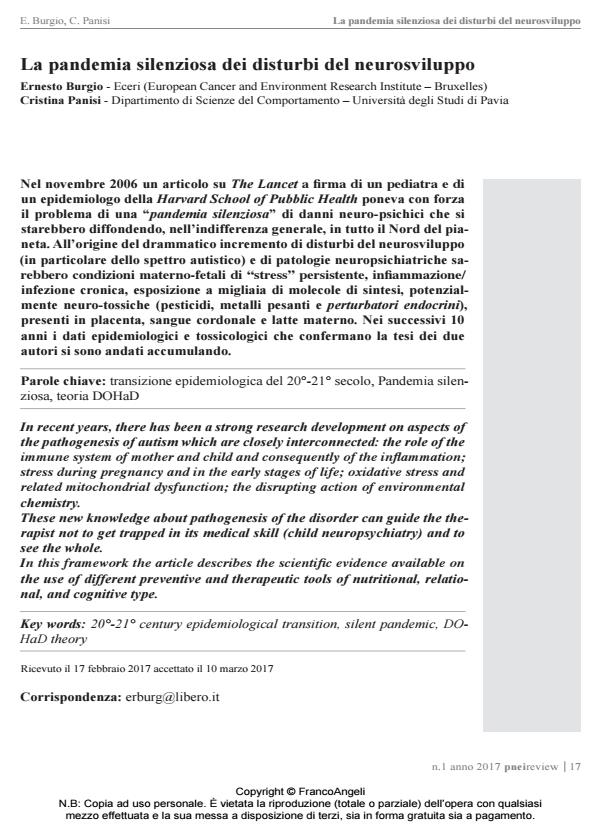La pandemia silenziosa dei disturbi del neurosviluppo
Titolo Rivista PNEI REVIEW
Autori/Curatori Ernesto Burgio, Cristina Panisi
Anno di pubblicazione 2017 Fascicolo 2017/1
Lingua Italiano Numero pagine 16 P. 17-32 Dimensione file 1125 KB
DOI 10.3280/PNEI2017-001003
Il DOI è il codice a barre della proprietà intellettuale: per saperne di più
clicca qui
Qui sotto puoi vedere in anteprima la prima pagina di questo articolo.
Se questo articolo ti interessa, lo puoi acquistare (e scaricare in formato pdf) seguendo le facili indicazioni per acquistare il download credit. Acquista Download Credits per scaricare questo Articolo in formato PDF

FrancoAngeli è membro della Publishers International Linking Association, Inc (PILA)associazione indipendente e non profit per facilitare (attraverso i servizi tecnologici implementati da CrossRef.org) l’accesso degli studiosi ai contenuti digitali nelle pubblicazioni professionali e scientifiche
Nel novembre 2006 un articolo su The Lancet a fi rma di un pediatra e di un epidemiologo della Harvard School of Pubblic Health poneva con forza il problema di una "pandemia silenziosa" di danni neuro-psichici che si starebbero diffondendo, nell’indifferenza generale, in tutto il Nord del pianeta. All’origine del drammatico incremento di disturbi del neurosviluppo (in particolare dello spettro autistico) e di patologie neuropsichiatriche sarebbero condizioni materno-fetali di "stress" persistente, infi ammazione/infezione cronica, esposizione a migliaia di molecole di sintesi, potenzialmente neuro-tossiche (pesticidi, metalli pesanti e perturbatori endocrini), presenti in placenta, sangue cordonale e latte materno. Nei successivi 10 anni i dati epidemiologici e tossicologici che confermano la tesi dei due autori si sono andati accumulando.
Parole chiave:Transizione epidemiologica del 20°-21° secolo, Pandemia silenziosa, teoria DOHaD
- Neurosviluppo e vaccini: dall'epigenetica alla clinica Cristina Panisi, Ernesto Burgio, in PNEI REVIEW 1/2018 pp.76
DOI: 10.3280/PNEI2018-001007
Ernesto Burgio, Cristina Panisi, La pandemia silenziosa dei disturbi del neurosviluppo in "PNEI REVIEW" 1/2017, pp 17-32, DOI: 10.3280/PNEI2017-001003